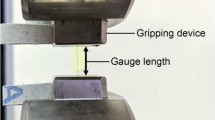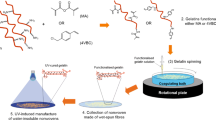Abstract
Polyglycolide (PGA) fibers applied as surgical sutures strongly depend on their microstructure. The structural evolution of PGA nascent fibers during single low-temperature stretching and segmented high-temperature stretching was analyzed based on a combination of in situ WAXD/SAXS and DSC measurements. The results indicated that the hot stretching was conducive to the crystal perfection and the local fragmentation and recrystallization of the lamellar crystals may occur under stress induction. The single low-temperature stretching of PGA nascent fibers could be divided into three stages: the stretching of amorphous regions, stretch-induced crystallization and the stretching of crystalline regions. The elongation at break of the fibers can be substantially increased by adopting a segmented stretching method, and the high-temperature stretching can also significantly increase the crystallinity and orientation. The amorphous orientation peak appearing in the low-temperature stretching was gradually converted to crystallization peak during the heating process, which greatly improved the crystallinity and orientation of the fibers. High-temperature stretching compared with low-temperature stretching was more favorable for crystal perfection and structural evolution, where lamellar crystals underwent stress-induced fragmentation recrystallization to transform to fibrous crystals as the strain increased.
Similar content being viewed by others
References
Malmir, S.; Montero, B.; Rico, M.; Barral, L.; Bouza, R.; Farrag, Y. Effects of poly(3-hydroxybutyrate-co-hydroxyvalerate) microparticles on morphological, mechanical, thermal, and barrier properties in thermoplastic potato starch films. Carbohydr. Polym. 2018, 194, 357–364.
Williams, C.K.; Hillmyer, M.A. Polymers from renewable resources: a perspective for a special issue of polymer reviews. Polym. Rev. 2008, 48, 1–10.
Ikada, Y.; Tsuji, H. Biodegradable polyesters for medical and ecological applications. Macromol Rapid Commun. 2000, 21, 117–132.
Wei, Y.H.; Xia, G. Q.; Wang, Y. S. Biodegradable polymer materials used in biomedical field. J. Yunnan Uni. 2004, 26, 121–124.
Zhu, Y. Q.; Romain, C.; Williams, C. K. Sustainable polymers from renewable resources. Nature 2016, 540, 354–362.
Malinova, V.; Meier, W. Polymer materials for biomedical applications. RSC Nanosci. Nanotechnol. 2010, 3, 3–15.
Zhao, Y.; Zhu, B.; Wang, Y.; Liu, C., Shen, C. Effect of different sterilization methods on the properties of commercial biodegradable polyesters for single-use, disposable medical devices. Mater. Sci. Eng. 2019, 105, 110041.
Fang, Y.; Li, Z.; Qiu, Z. Miscibility and crystallization behavior of biodegradable poly(3-hydroxybutyrate-co-3-hydroxyvalerate)/phenolic blends. J. Appl. Polym. Sci. 2011, 123, 2781–2786.
Doppalapudi, S.; Jain, A.; Khan, W.; Domb, A. J. Biodegradable polymers—an overview. Polymer 2014, 25, 427–435.
Wisniewska, K.; Rybak, Z.; Watrobinski, M.; Struszczyk, M. H.; Filipiak, J.; Zywicka, B.; Szymonowicz, M. Bioresorbable polymeric materials-current state of knowledge. Polimery 2021, 66, 3–10.
Naira, L. S.; Laurencina, C. T. Biodegradable polymers as biomaterials. Prog. Polym. Sci. 2007, 32, 762–798.
Liang, H. G.; Huang, K. Development status and trend of biomedical polymer materials. New Mater. Ind. 2016, 2, 12–15.
Landes, C. A.; Ballon, A.; Roth, C. Maxillary and mandibular osteosyntheses with PLGA and P(L/DL)LA implants: a 5-year inpatient biocompatibility and degradation experience. Plast. Reconstr. Surg. 2006, 117, 2347–2360.
Singhal, J. P.; Singh, H.; Ray, A. R. Absorbable suture materials: preparation and properties. J. Macromol. Sci., Rev. Macromol. Chem. Phys. 1988, 28, 475–502.
Gomzyak, V. I.; Demina, V. A.; Razuvaeva, E. V.; Sedush, N. G.; Chvalun, S. N. Biodegradable polymer scaffolds to regenerate organs. Fine Chem. Technol. 2017, 12, 5–20.
Lim, L. T.; Auras, R.; Rubino, M. Processing technologies for poly(lactic acid). Prog. Polym. Sci. 2008, 33, 820–852.
Shawe, S.; Buchanan, F.; Harkin-Jones, E.; Farrar, D. A study on the rate of degradation of the bioabsorbable polymer polyglycolic acid (PGA). J. Mater. Sci. 2006, 41, 4832–4838.
Gilding, D. K.; Reed, A. M. Biodegradable polymers for use in surgery-polyglycolic/poly(lactic acid) homo- and copolymers. Polymer 1979, 20, 1459–1464.
Cui, A.J.; Li, Z.F.; C, Q.; He, M. Y. Biodegradable material polyhydroxyacetic acid and its crystallization properties. New. Che. Mater. 2012, 40, 87–90.
Martin, O.; Avérous, L. Poly(lactic acid): plasticization and properties of biodegradable multiphase systems. Polymer 2001, 42, 6209–6219.
Fu, B. X.; Hsiao, B. S.; Chen, G.; Zhou, J.; Lin, S.; Yuan, J.; Koyfman, I.; Jamiolkowski, D. D.; Dormier, E. A study of structure and property changes of biodegradable polyglycolide and poly(glycolide-co-lactide) fibers during processing and in vitro degradation. Chinese J. Polym. Sci. 2003, 21, 159–167.
Fu, B. X.; Hsiao, B. S.; Chen, G.; Zhou, J.; Koyfman, I.; Jamiolkowski, D.; Dormier, E. Structure and property studies of bioabsorbable poly(glycolide-co-lactide) fiber during processing and in vitro degradation. Polymer 2002, 43, 5527–5534.
Zong, X. H.; Wang, Z. G.; Hsiao, B. S.; Chu, B.; Zhou, J. J.; Jamiolkowski, D. D.; Muse, E.; Dormier, E. Structure and morphology changes in absorbable poly(glycolide) and poly(glycolide-co-lactide) during in vitro degradation. Macromolecules 1999, 32, 8107–8114.
Wang, Y.; Li, M.; Shen, C. Effect of constrained annealing on the microstructures of extrusion cast polylactic acid films. Mater. Lett. 2011, 65, 3525–3528.
Wang, Y. M.; Li, M.; Wang, K. J.; Shao, C. G.; Li, Q.; Shen, C. Y. Unusual structural evolution of poly(lactic acid) upon annealing in the presence of an initially oriented mesophase. Soft Matter 2014, 10, 1512–1518.
Shen, C. Y.; Wang, Y. M.; Li, M.; Hu, D. F. Crystal modifications and multiple melting behavior of poly(L-lactic acid-co-D-lactic acid). J. Polym. Sci., Part B: Polym. Phys. 2011, 49, 409–413.
Lorenzo, A. T.; Arnal, M. L.; Sanchez, J. J.; Muller, A. J. Effect of annealing time on the self-nucleation behavior of semicrystalline polymers. J. Polym. Sci., Part B: Polym. Phys. 2006, 44, 1738–1750.
Yan, R. J. Uniaxial tensile and oriented structure of crystalline polymers. I. Deformation mechanism of tensile crystalline polymers. Polym. Bull. 1993, 230–233.
Yan, R. J. Uniaxial tensile and oriented structure of crystalline polymers. II. Structural model and plastic deformation of oriented crystalline polymers. Polym. Bull. 1994, 26–30.
Termonia, Y., Smith, P. Kinetic model for tensile deformation of polymers. 5. Effect of temperature on orientation efficiency. Macromolecules 1993, 26, 3738–3741.
Li, J. Structure and properties of glycolide-L-lactide copolymer fiber during drawing. Tianjin University, 2007.
Li, J.; Huang, Q.; Li, X. Crystallization and orientation of P(GA-co-LA) fibers during drawing process. J. Textile Res. 2011, 32, 1–5.
Huang, Q.; Gao, X. S.; Xu, J. G.; Li, J.; Wu, P. F. The crystallization properties of P(GA-co-LA) fibers during molding. Synthetic Fiber 2009, 12, 9–13.
Mu, W. M.; Zheng, Q. J. Development of polyglycolide and polyglycolide suture. Synthetic Fiber 1991, 020, 24–29.
Dong, Z.; Miao, Y.; Cui, H.; Huang, Q.; Li, Y.; Wang, Z. Structural evolution of polyglycolide and poly(glycolide-co-lactide) fibers during heat-setting. Biomacromolecules 2021, 22, 3342–3356.
Hammersley, A.P.; Svensson, S.O.; Thompson, A. Calibration and correction of spatial distortions in 2D detector systems. Rev. Sci. Instrum. 1995, 346, 312–321.
Li, S. M.; Vert, M. Biodegradation of aliphatic polyesters. Degrad. Polym. 2002, 4, 123–135.
Alexander, L. E. X-ray diffraction methods in polymer science. J. Mol. Struct. 1971, 6, 93.
Kortleve, G.; Vonk, C. G. X-ray small-angle scattering of bulk polyethylene. J. Mol. Struct. 1968, 225, 124–131.
Tang, Y.; Jiang, Z.; Men, Y. Uniaxial deformation of overstretched polyethylene: in situ synchrotron small angle X-ray scattering study. Polymer 2007, 48, 5125–5132.
Ruland, W. Small-angle scattering studies on carbonized cellulose fibers. J. Polym. Sci., Part C: Polym. Symp. 1969, 28, 143–151.
Perret, R.; Ruland, W. Single and multiple X-ray small-angle scattering of carbon fibers. J. Appl. Crystallogr. 1969, 2, 209–218.
Qian, R.; Wu, L.; Shen, D.; Napper, D. H.; Mann, R. A.; Sangster, D. F. Single-chain polystyrene glasses. Macromolecules 1993, 26, 2950–2953.
Qian, R. Some basic physical problems of polymer condensation state. Bull. Chin. Acad. Sci. 2000, 3, 174–177.
Ran, S. F.; Wang, Z. G.; Burger, C. B.; Chu, B.; Hsiao, B. S. Mesophase as the precursor for strain-induced crystallization in amorphous poly(ethylene terephthalate) film. Macromolecules 2002, 35, 10102–10107.
Sato, H.; Miyada, M.; Yamamoto, S.; Raghunatha Reddy, K.; Ozaki, Y. C−HO (ether) hydrogen bonding along the (110) direction in polyglycolic acid studied by infrared spectroscopy, wide-angle X-ray diffraction, quantum chemical calculations and natural bond orbital calculations. RSC Adv. 2016, 6, 16817–16823.
Lee, S.; Hongo, C.; Nishino, T. Crystal modulus of poly(glycolic acid) and its temperature dependence. Macromolecules 2017, 50, 5074–5079.
Acknowledgments
This work was financially supported by the National Natural Science Foundation of China (Nos. 51973097 and 52173021) and the Open Fund of State Key Laboratory of Biobased Fiber Manufacturing Technology (No. SKL202207). We thank Shanghai Synchrotron Radiation Facility (SSRF) for supporting the SAXS and WAXD tests.
Author information
Authors and Affiliations
Corresponding author
Ethics declarations
The authors declare no interest conflict.
Electronic Supplementary Information
Rights and permissions
About this article
Cite this article
Miao, YS., Cui, HS., Guo, J. et al. Structural Evolution of PGA Nascent Fiber during Single Low-Temperature and Segmented High-Temperature Hot Stretching. Chin J Polym Sci 41, 1078–1092 (2023). https://doi.org/10.1007/s10118-023-2892-8
Received:
Accepted:
Published:
Issue Date:
DOI: https://doi.org/10.1007/s10118-023-2892-8




